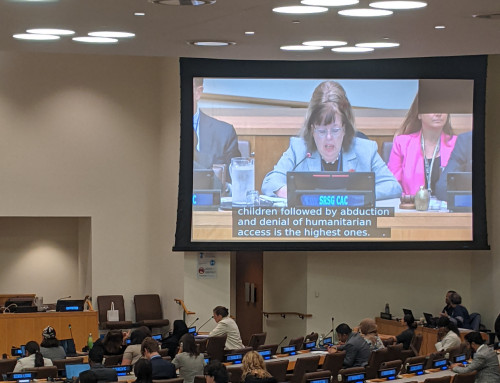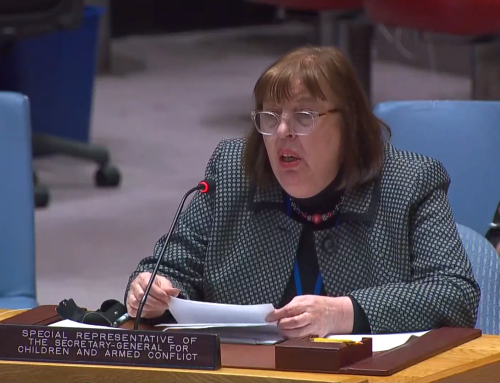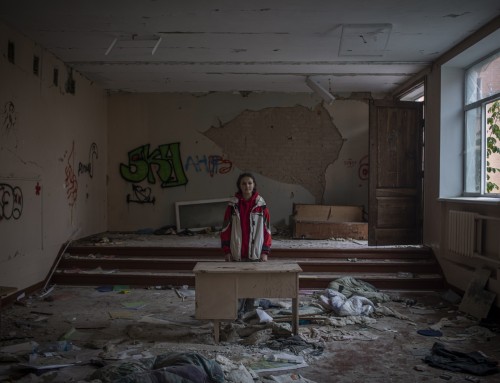21 November 2001
Fourth Open Debate in the Security Council
Statement in the UN SECURITY COUNCIL
on the occasion of fourth Open Debate on CHILDREN AND ARMED CONFLICT
by Olara A. Otunnu
Under-Secretary-General
Special Representative of the Secretary-General for Children and Armed Conflict
Tuesday, 20 November 2001
New York
This is the fourth Open Debate of the Security Council devoted to the protection, rights and rehabilitation of children affected by armed conflict (CAAC). Since 1998 we have seen the progressive integration of these concerns into the peace-and-security agenda of the United Nations. This has resulted in an impressive body of practice, key elements of which include:
Placing war-affected children on the agenda of the Security Council: this is exemplified by SC resolution 1261, which formally affirmed that the protection and well-being of CAAC is a fundamental peace-and-security concern, and SC resolution 1314, wh
The progressive inclusion of child protection provisions into UN peacekeeping mandates.
The creation of the role and the deployment of Child Protection Advisers (CPAs) with peacekeeping operations.
Tangible progress has been made in incorporating CAAC into peace agendas and peace accords; examples include, the Lomé Peace Accord for Sierra Leone and the Arusha Peace and Reconciliation Agreement for Burundi.
The Security Council now addresses CAAC issues regularly, in discussions of particular conflict situations and the formulation of specific resolutions.
Children are beginning to receive increasing priority, focus and resource allocation in the context of post-conflict policies and programs; we are seeing this today in East Timor, Sierra Leone, Kosovo and Guatemala.
An important consensus has developed on An appropriate framework for the protection and participation of children in the context of judicial tribunals and truth-seeking processes intended to address serious abuses committed against, and sometimes by, children during armed conflict.
Child protection sections have now become An established feature of regular reports to the Security Council on specific conflict situations as well as on thematic concerns.
the holding, on An annual basis, of An open-debate devoted to CAAC.
In spite of the impressive progress that has been registered in terms of advocacy, public opinion, policies and programmes, I regret to report that the overall situation of children exposed to war remains grave and entirely unacceptable. The magnitude and details of this situation are set out in the Report of the Secretary-General, which is before you.
We share a common preoccupation: how to change this situation for children on the ground. In this context, I should like to underscore certain measures, drawn from the Report of the Secretary-General to the Security Council and the draft resolution before you, which I believe to be particularly important, for your consideration.
Coming into force of Optional Protocol. We have good news on the Optional Protocol on the involvement of children in armed conflict. We have recently attained the required threshold of ten instruments of ratification. This means that this important treaty will enter into force in February 2002. I am also encouraged by the fact that 46 countries have ratified the Rome Statute of the International Criminal Court, which makes it a war crime to recruit or use children under age fifteen as soldiers.
We must undertake tangible action to ensure the application of the Optional Protocol in theatres of conflict, through effective monitoring of conduct and the mobilization of concerted pressure.
We need to mobilize adequate resources for programmes of demobilization and social rehabilitation for children who have been made to participate in conflict.
We must turn our attention to, and place particular priority on addressing key political, social and economic factors that create an environment favourable to the alienation, exploitation, and indoctrination of children and youth, thus facilitating their involvement and participation in conflict.
Monitoring the conduct of parties to conflict. There is an urgent need for the international community to organize a more systematic and effective way of monitoring and reporting on the conduct of parties to conflict, in relation to their treatment of children. Who is brutalizing and targeting children – – when and where? Which parties to conflict are observing or flouting their obligations and commitments concerning the protection and rights of children? Such monitoring and reporting, conducted on an objective and impartial basis, would then serve as the basis for concerted action, triggering targeted advocacy and moblization of pressure, by all concerned.
Strengthening the integration of CAAC into peacemaking, peacekeeping and peace-building processes. We are eager to learn from the collective experience built thus far. For this reason, my Office and DPKO, with UNICEF and DPA, have established an informal inter-agency working group to strengthen these on-going initiatives to incorporate child protection into peacemaking, peacekeeping and peace-building processes. The Security Council has in fact called upon parties to armed conflict to incorporate child protection concerns into peace agreements and into plans for post-conflict re-building. This informal working group will produce the tools and guidelines necessary to facilitate this.
Child Protection Advisers. The appointment of Child Protection Advisers represents an important innovation for integrating child protection concerns into peacekeeping operations. This experience needs to be strengthened and given wider application, wherever children are significantly affected by conflict. In this connection, developments in Afghanistan and Burundi present immediate opportunities for designing child-conscious mission mandates and for deploying child protection advisers.
Providing adequate training for peacekeeping personnel. To further strengthen child protection in peacekeeping as called for by the Security Council, my Office, UNICEF and the Swedish NGO Radda Barnen, in collaboration with DPKO, have convened an informal working group on child protection training for peace-keeping personnel. This group will produce a complete training package on child rights and protection for use by personnel in all UN multi-dimensional peace operations. I would reiterate the Secretary-General's appeal to Member States to undertake similar training efforts at the national level with personnel being deployed to UN operations.
Eliminating impunity for crimes committed against children in war-time. When improved standards of protection, systematic monitoring and reporting fail to deter the commission of serious crimes against children in times of war, then those responsible should be prosecuted and punished in accordance with international guarantees of due process. War crimes and other egregious abuses of children in war-time should be excluded from amnesty provisions in peace agreements and legislation. Post-conflict truth and justice-seeking mechanisms should address the full range of children's experiences in armed conflicts and should reveal the contexts in which those abuses took place.
Children and the illicit exploitation of natural resources. A particular scandal in today's warfare is the pillage of natural resources by parties to armed conflict. This is robbing children of their birth right. Resources that should provide for rehabilitation, education, health care and nutrition for children are instead being plundered by networks of local, regional and international actors. Who is reaping the benefits from the rich diamond resources of Angola and Sierra Leone? Or the diamond, gold, coltan, timber and coffee of the DRC? Certainly not the children of those countries. Moreover, this has become the means of fueling and prolonging conflicts in which children suffer the most. For the children of Angola, Sierra Leone and DRC, the blessings of natural resources are instead a curse. I urge the Security Council to redouble its efforts in this regard. I suggest that targeted measures be taken against parties to conflict, and other complicit actors, and that peacekeeping mandates provide for the monitoring of compliance with such measures.
Protecting girls in situations of armed conflict. The international community is not doing enough to prevent harm to girls in times of war and to ensure appropriate recovery and rehabilitation services in war's aftermath. Several recent examples underscore their very particular vulnerability in situations of war: girls in Rwanda suddenly became the heads of some 60,000 households in the aftermath of the genocide; girls have been trafficked from the Balkans into prostitution rings in western Europe; school girls are abducted by the LRA in Northern Uganda; girls have been systematically denied education in Afghanistan. In January 1999 the RUF abducted over 4,000 children from Freetown – – 60% of these were girls, and yet few girls are being demobilized today in Sierra Leone. And sadly there are fighting groups whose preferred agents to serve as suicide commandos remain girls. We must do a lot more to protect and rehabilitate girls exposed to war. I appeal to the Security Council to help ensure that the special needs of girls are accounted for and monitored in peacemaking and peace-building processes. I urge Member States and donors to attach sustained and adequate resources to programmes that reduce girls' vulnerability and promote their recovery and reintegration in war's aftermath.
Spread of HIV/AIDS in the corridors of war. Last year, the Security Council took note for the first time that reduced access to education, preventative programs and health care, coupled with the market for commercial sex by traveling soldiers and armed groups makes conflict a very effective environment for the spread of HIV/AIDS. HIV/AIDS creates orphans, which leads to greater instability of regions in general and HIV/AIDS ultimately kills many of those girls who suffer deliberate exploitation as “camp followers” or “bush wives”. I urge the Security Council to continue to look at ways that HIV/AIDS can be combated in this arena, and to pay particular attention to HIV/AIDS and children when conducting visits to war-affected countries. Education for peacekeeping personnel and the identification of, and provision of appropriate counseling and treatment for, children exposed to the virus are essential.
Children and post-conflict peacebuilding. The challenge and costs of ensuring sustained attention to child protection and rights in the aftermath of armed conflict cannot be overstated. The Security Council and Member States can do more to help ensure that foreseeable concerns – such as the need to rebuild health and educational infrastructures, strengthen the administration of juvenile justice and child welfare programmes, ensure vocational training and occupational opportunities for young people in war's aftermath — are raised at the earliest stages in peace-building. It is particularly important to involve local communities and support them in war-torn areas so that child protection initiatives can be appropriately targeted and sustained over the long-term. We must take advantage of the opportunities presented today in Sierra Leone, Kosovo and East Timor, among other places, to keep children's concerns at the forefront of peace-building.
Filling knowledge gaps on CAAC. Unless critical knowledge gaps are filled, our interventions on behalf of children are likely to be less than fully effective. It is clear that our collective work – – policy-makers, practitioners, advocacy groups, the donor community – – would be greatly enhanced by the availability of more reliable data and knowledge. For this reason, I have proposed a Research Agenda on the Impact of Armed Conflict on Children, to focus on filling knowledge gaps in the following key areas: reliable data on children and armed conflict; current trends in warfare affecting children; cultural norms and values concerning the protection of children in times of armed conflict; assessment of program interventions and responses, including indicators to assess the effectiveness of programmes, 'best practices' and 'lessons learnt.' The idea is to generate research outcomes and products that are responsive to practical needs, and help to inform and strengthen policy-making and action. A network, composed of scholars, research institutions, UN agencies, NGOs, is being constituted to undertake the collection, analysis and sharing of such information. The support of Member States for the research network will be vital to its success.
Placing children at the forefront of the response to the situation in Afghanistan. We meet at a time when our collective attention is focused on Afghanistan. Indeed at this very moment a very important meeting is taking place in Washington, convened by Japan and the United States on the recovery and reconstruction of Afghanistan.
18% of children in Afghanistan die before the age of one and 25% die before the age of five (the fourth highest child-mortality rate in the world); 60 % of these deaths are due to preventable diseases
50% of the children suffer from malnutrition
an estimated 2 million children are refugees or internally displaced persons
40% of children living in Kabul have lost at least one parent; there are about 700,000 war widows in the country
children account for over 30% of some 100,000 land mine victims in a country estimated to have 10 million mines
50,000 street children in Kabul are the primary income earners for their households and there are thousands of street children among refugees in neighbouring countries
Thousands of children have been enrolled into combat by the Taliban and Northern Alliance
Many children have been exposed to radical programmes of indoctrination and ideologies of conflict
However, while properly focusing on the serious situation in Afghanistan, we must not lose sight of the needs of other war-affected children who equally need out attention and support.
Before concluding my remarks, I hope you will forgive me Madame President, for invoking the voice of Jamaica's favourite son – – your special gift to the world – – whose powerful voice gave the world the gift of reggae music. Bob Marley's often deeply spiritual renditions of the themes of suffering and redemption seems particularly appropriate for our deliberations today. I hear Bob Marley's voice calling us to action on behalf of children:
Hearing the children cryin'
Hear the children cryin'
We had told them in yesteryears
Don't worry about a thing
'Cause every little thing gonna be all right.
Hear the children cryin'
From Afghanistan to Angola
Asking for the same thing
One Love.
Hear the children cryin'
From the Balkans to Burundi
Waiting for the same thing
Redemption Songs. Redemption Songs.
Won't you help to sing
Dese songs of redemption
Rendering hope and protection.
I hear three little birds
Perched on the door steps of the Council
Singin' melodies pure and true
Sayin' again and again
This is our message to you-ou-ou.





